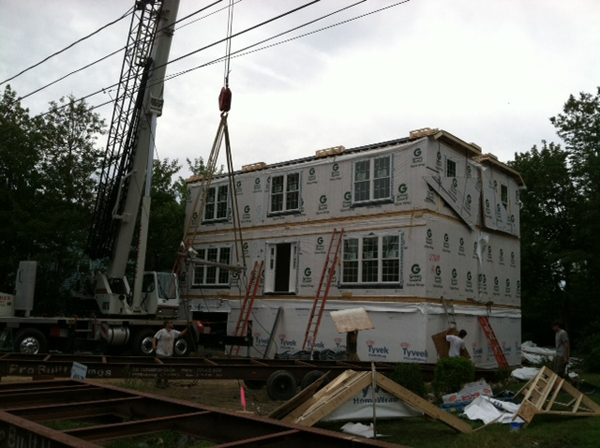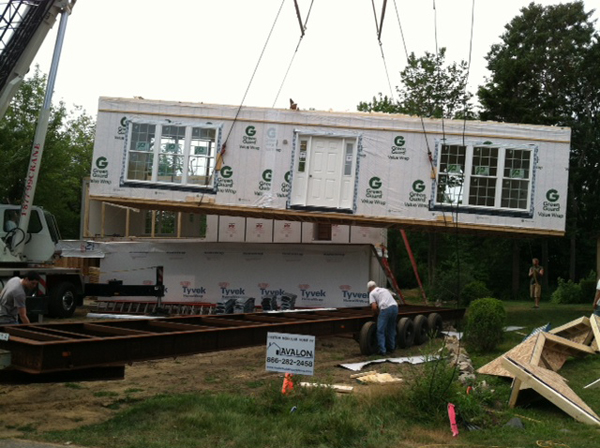CALL 888-764-1297
Magnificently Built Modular Homes
 There is very little difference in the look of a modular home compared to a traditional on-site built home.
There is very little difference in the look of a modular home compared to a traditional on-site built home.
The modules are built in a climatically controlled plant to exacting standards. Then they are trucked to the site and placed together on a foundation.
The concept of modular homes offer the same advantages to the owner of the typical home. Modular homes are built to rigorous standards dictated by local building codes. They are constructed in manufacturing plants involving stringent time lines of construction.
Manufactured homes are built to the highest standards of energy efficient living and can include high-efficiency furnaces and heat pumps to reduce your utility bills.
Factory manufacturing of modular home components means less transport of workers and materials, allows for effective use of energy and materials, and reduced waste. Designs can be easily customized.
All of these homes must meet all applicable state and local building codes.
When purchasing your next home, investigate the manufactured and modular housing options may be available you. Contact Avalon Building Systems.
The Province

Always an affordable choice, today’s modular homes offer the same design features as traditional home choices, but for far less. Numerous studies have been conducted to show the cost-efficiency of factory built homes. The website, www.nest.com, published a report which stated, “the cost of a finished modular house in the Northeast is $90 to $125 per square foot, compared to $150 to $200 a square foot for stick-built construction.
Unlike traditional homes, the construction process for factory-built homes, or modular homes, takes much less time. Weather delays do not impact the process. The building supplies themselves are also not subject to weather damage or theft. Generally, the construction time for a modular home takes approximately 6 to 8 weeks after the design phase is complete, compared to the 6-12 month time frame typical with a site-built home.
For more information on Modular Construction, contact Avalon Building Systems.
American Financial Resources

The revolution of modular construction means that consumers can have a better built, lower cost home that is built in a climate controlled factory. The home is then delivered to a building site on your schedule. No longer are homeowners tied to the traditional seasonal cycle and seasonal demand of regular contractor’s schedule. A modular home can be built year round and takes advantage of the off season costs that are likely lower.
For more information on building a modular home, contact Avalon Building Systems.
SB Wire

On average, modular homes take about five months to complete, compared to 6.9 months for a traditional site-built home, and this average savings of roughly two months has been consistent over time.
Modular homes also tend to be slightly smaller, with an average of 1,902 square feet, compared to 2,387 for site-built, and less expensive, with average permit value of $76.80 per square foot versus $94.34 for site-built.
U.S. Census data show that modular homes are more often in the northeastern part of the country, with particular market growth in New York and Virginia.
For 2012, 12-month modular construction is projected to be about 13,300 homes, a 9.4 percent increase over 2011.
For information in building a modular home, contact Avalon Building Systems.
Reading Eagle Business Weekly

"We've seen a 25% increase in demand for multigenerational homes over the past two years and expect to see more," said the CEO of a company which specializes in building custom modular homes.
Though factors such as high unemployment, a battered economy and the recent housing crisis have pushed more people into multigenerational living, studies show that it's a trend that's circled back from days past.
The number of Americans living with their extended family has risen again -- spiking as the Great Recession hit in 2008. The Pew Research Center now estimates that 16% of Americans live in multigenerational households.
The Future of Housing
The rise in multigenerational households over the past few years has changed the landscape of modern home construction. Many families are now looking to either build a multigenerational-friendly home from scratch -- more informally known as the "in-law" setup; or retrofit their existing home with a modular addition to accommodate extended family.
The most common renovation would have to be adding entire wings to an existing house. If they're modular additions, they can take anywhere from four to six weeks to complete.
Usually the wings are 600 to 800 square feet, depending on the town and their guidelines. It's much more economical to add on, as you're able to customize the addition with high-end amenities.
For more information on multi family modular homes or modular additions, contact Avalong Building Systems.
Excerpts - AOL Real Estate

Hundreds of families are in need of replacement homes in New Jersey and Long Island and modular construction is fast, efficient and built in compliance with all local and state codes. There is no reason to settle. You can put your life together faster when you build a modular home.
We are reaching our directly to the affected families, insurance adjusters, insurance companies, and those providing aid, we want to help.
With Avalon Building Systems, you know that you are dealing with an established and reputable modular home company that will provide you a quality custom modular home in 4 – 6 weeks, with a fixed price. Contact us, or call our toll free number for more information 888-764-1297.

After the house was delivered, it took 15 days for it to be completely done. It is an incredibly fast process.
The new four- bedroom modular house came with all the energy efficiency and chic "green" design the family desired – in a fraction of the time. Helping to keep the family warm in winter are double-thick insulated walls, or SIP panels.
"We custom-built our last home, " Josifovski said. "It was three years of hell with constant overruns and overtime. I became so convinced that modular homes are the right way to build."
Amid the slumping housing industry, the popularity of modular homes is growing. Among their selling points: Energy (and money) savings come built in.
At Avalon Building Systems, our modular homes are LEED Platinum-certified with Energy Star-rated appliances and SIP panels.
All of those options were installed at the factory. Situated on a lot, the house is then delivered in pieces and assembled in hours.
Think of the modules like big Legos, but they have to comply with all local building codes.
Because the homes are built in a factory, there's less construction waste and there's also more quality control.
Green technology tends to cost more. But by factory-installing those options, the final price tag comes down. And as more people become interested, these sustainable options become more affordable.
The largest market for modular homes may be baby boomers that are looking for a modern easy-care but sustainable home for retirement.
The speed of installation grabs many customers. Modular Homes can be completed in the factory in a few months. Meanwhile, the home site is prepared and construction permits finalized. Then, installation seems almost instantaneous.
People love the speed. You get a custom built home with all energy-efficient extras, but cut way down on the build time. The people who buy our homes want a nice house, they want it green and to work in a real economy – and they want it fast.
For more information, contact Avalon Building Systems.
Sacramento Bee

Instead of the old-fashioned construction method, most of the work is done at an off-site climate controlled factory. As each module is finished it is transported to the building site and assembled. The finishing touches are then completed and your new modular homes looks just like a stick built home, but better.
Modular construction projects have grown in popularity over the last 10 years. Why? Because modular construction offers both time and cost savings. The modules for the modular homes are built as if in an assembly line, which delivers much higher efficiency and quality. Because they are built inside a factory, there are no weather delays which and labor costs are reduced.
For more information on Modular homes and the modular construction process, contact Avalon Building Systems.

"Housing is becoming out of reach for too many," says New York Building Congress President Richard Anderson.
Building modular buildings, for residential and commercial use has been around for a number of years
The average savings can be 5% to 20% with modular construction, along with a whole lot of time, and the modular home business has been picking up a lot in the last several years.
Some of the increased business is because we're coming out of the recession and we're seeing more activity, but a lot of is it because modular homes are really catching on.
Modular construction might go a long way toward helping to keep the building industry competitive.
"Innovation in the construction industry is always important because we're the highest cost construction market in the country, and we are encouraging people to look for ways to economize, to look to do things differently, and in a better way," says Anderson.
For more information on modular home construction, contact Avalon Building Systems.
NY1.com
 These days, there are many modular construction options available that are green, beautiful, well-made, and often lower-cost. Modular homes can be modest year round homes, estates or vacation homes or modular additions.
These days, there are many modular construction options available that are green, beautiful, well-made, and often lower-cost. Modular homes can be modest year round homes, estates or vacation homes or modular additions.
Modular homes come in a wide range of sizes, from one bedroom spaces and small units to larger sized homes. They are also available in a wide variety of styles from traditional designs to modern to completely custom designed. Most of the modular floor plans can be modified or customized.
Prefab homes have many benefits. They can be built more efficiently (e.g., less material waste), more quickly, with more precision and durability (i.e., higher quality), and they typically have more predictable costs (and often cost less) than site-built homes.
The levels of greenness vary among the following options, but all of them tout some green features.
For information on building a greener home, contact Avalon Building Systems.
Mother Earth News
HOME | COMMERCIAL | RESIDENTIAL | MODULAR BENEFITS | FLOOR PLANS | GALLERY | FINANCIAL INFO | TESTIMONIALS | ABOUT | CONTACT | BLOG | SITE MAP